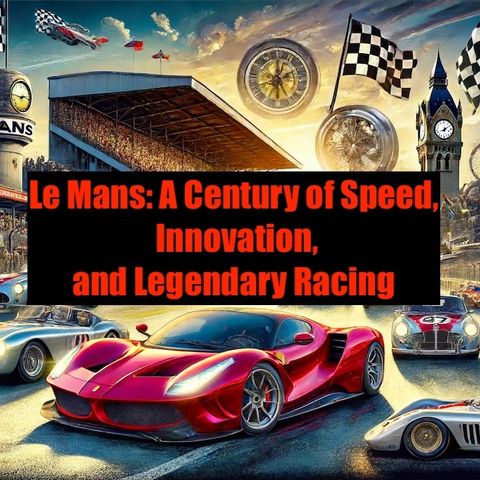Le Mans- A Century of Speed, Innovation, and Legendary Racing

Regístrate gratis
Escucha este episodio y muchos más. ¡Disfruta de los mejores podcasts en Spreaker!
Descarga y escucha en cualquier lugar
Descarga tus episodios favoritos y disfrútalos, ¡dondequiera que estés! Regístrate o inicia sesión ahora para acceder a la escucha sin conexión.
Descripción
The History of the Le Mans Road Race: A Grueling Test of Endurance and Innovation The 24 Hours of Le Mans, established in 1923, is held near the town of...
mostra másThe 917's victory in 1971, during which it covered a record-breaking distance of 5,335 kilometers, remains one of the most iconic moments in Le Mans history, etching the car's name into the annals of motorsport folklore. Porsche's commitment to innovation and technological superiority continued throughout the 1970s and 1980s, with the introduction of turbocharging technology and the development of models like the 935 and 936, each pushing the boundaries of what was possible in endurance racing. Group C Era and Modernization The 1980s also witnessed the introduction of the Group C regulations, which placed a renewed emphasis on fuel efficiency and aerodynamic performance. This era ushered in a new era of intense competition between legendary manufacturers like Porsche, Jaguar, Mercedes-Benz, and Nissan, each vying for supremacy on the iconic Circuit de la Sarthe. The 1988 race, in particular, stands out as a defining moment in Le Mans history, as Jaguar broke Porsche's stranglehold on the event with the victory of the XJR-9. This triumph marked a return to glory for the British manufacturer, a symbolic passing of the torch to a new generation of endurance racing machines. The technological advancements that characterized the Group C era, including the development of ground-effect aerodynamics and advanced engine management systems, set the stage for the modernization of endurance racing. These innovations not only pushed the limits of performance but also laid the foundation for the sustainability and efficiency that would become hallmarks of the sport in the 21st century. Hybrid Era and Environmental Focus As the world entered the 21st century, the automotive industry began a seismic shift towards hybrid and electric technology, a trend that would ultimately shape the future of endurance racing. Manufacturers like Audi, Toyota, and Porsche led the charge, using the 24 Hours of Le Mans as a platform to develop and showcase their cutting-edge hybrid powertrains. In 2012, Audi's R18 e-tron quattro became the first hybrid car to claim overall victory at Le Mans, ushering in a new era of environmentally conscious racing. This milestone was soon followed by successive victories for other hybrid models from Toyota and Porsche, cementing the ascendancy of this technology in the world of endurance racing. This shift towards hybrid and electric powertrains reflects the broader trends in the automotive industry towards sustainability and environmental responsibility. Le Mans has long been a proving ground for technological innovation, and the embrace of hybrid and electric technology represents a natural evolution for a race that has always pushed the boundaries of what is possible. Ferrari's Return to Glory: The 2024 Victory In June 2024, the automotive world witnessed a momentous occasion as Ferrari, one of the most iconic and revered names in motorsport, defended its title and secured victory in the 24 Hours of Le Mans with the 499P Hypercar. This triumph marked a significant achievement in the brand's storied racing history and served as a powerful reminder of Ferrari's enduring prowess in endurance racing. The race was fiercely contested, with Ferrari's team demonstrating remarkable strategy, reliability, and driver skill in their pursuit of victory. From the opening laps to the final hours, the 499P Hypercar proved to be a formidable machine, capable of withstanding the grueling demands of the Circuit de la Sarthe while delivering blistering pace and unparalleled performance. Ferrari's victory in 2024 was not merely a triumph of speed and engineering; it was a celebration of the brand's rich heritage and unwavering commitment to excellence. The Prancing Horse has been a fixture at Le Mans since the early days of the race, and its latest success serves as a testament to the enduring spirit of innovation and competition that has defined Ferrari for generations. Beyond the thrill of the race itself, the 24 Hours of Le Mans holds a special place in the hearts of motorsport enthusiasts around the world. The event is steeped in history and tradition, with each passing year adding new chapters to its rich and storied legacy. For drivers, the opportunity to compete at Le Mans is a dream come true, a chance to etch their names into the annals of motorsport history alongside the legends of the past. The grueling 24-hour format demands not only supreme skill and physical endurance but also a mental toughness that separates the true greats from the res
Información
| Autor | QP-4 |
| Página web | - |
| Etiquetas |
Copyright 2024 - Spreaker Inc. an iHeartMedia Company
